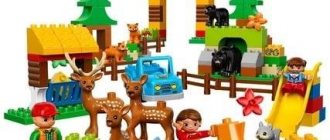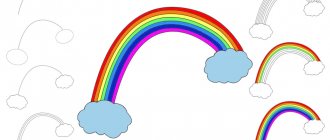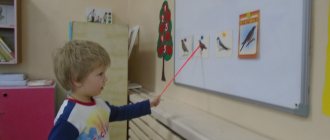Games for preschoolers with Cuisenaire sticks
Consultation for parents of preschool children “Play with Cuisenaire sticks”
Author: Shchipitsina Marina Ivanovna, teacher-psychologist MBDOU “Savinsky kindergarten”, Savino village, Perm region, Karagai region. Description of the material: this publication is intended for parents, psychologists and educators working with children of the middle and senior groups. The material will help diversify the forms and methods of developing children's mathematical abilities. Goal: increasing the psychological and pedagogical competence of parents and teachers.
One of the most important tasks in raising a small child is the development of his mind, the formation of such thinking skills and abilities that make it easy to learn new things.
Games and research help satisfy children’s natural needs for knowledge and study of the world around them, and their insatiable curiosity. Teachers from different countries adapt and develop technologies for using long-known Russian and foreign didactic tools (B. Nikitin’s educational games, Dienesh blocks, Lego, Cuisenaire’s counting sticks, etc.), expanding the horizons of the world educational space. The development and implementation of effective didactic tools and developmental methods allows teachers and parents to diversify their interaction with children and introduce complex, abstract mathematical concepts in a form accessible to children. With the help of Cuisenaire sticks you will solve many problems: - Arouse interest in playing with Cuisenaire sticks and a desire to act with them.
- develop elementary mathematical concepts - about number based on counting and measurement. - will help you master the key means of cognition - sensory standards (standards of color, size), such methods of cognition as comparison, juxtaposition of objects (by color, length, width, height). — will help you master spatial and quantitative characteristics. — teach children to understand the task and solve it independently. - develop the skills of self-control and self-esteem. Exercise “Selecting ribbons for aprons
.
Give the child aprons of the entire color range of Cuisenaire sticks and ask them to choose the appropriate sticks - “ribbons” for the aprons and name their color: “this is a red ribbon, and this one is the same”; “this yellow and this yellow”, etc.
“We are walking along a ladder” Offer to lay out a numerical ladder, find a stick “1” - what color, it is proposed to lay it in front of you, “2” - what color, put it under a white stick (or next to a white one), so that you get a step, etc. d.
“Fences low and high” Build fences for different houses from sticks, laying them vertically next to each other. Comparison of fences by height. “High ladder and low ladder” Together with your child, build ladders to houses of different heights.
“The ladder is wide and the ladder is narrow” Build ladders for two different people - one fat and the other thin.
“Bridges over the river”, “Rafts on the river” Each child outlines exactly where in the river he will build a bridge, and selects sticks of the appropriate length for it so that their length covers the width of the river. Offer to build rafts on which you can sail under the bridge.
Help us come to the conclusion that the openings of the bridge are different (“narrow”, “wider”, “wide”). “Color and Number”, “Number and Color” Invite your child to build an unusual train from colored sticks, put passengers in the carriages, children are asked to find out how many seats there are in each carriage, children find the answer in a practical way: take white sticks and put them on each carriage colors.
Build a trailer yourself from 4 white sticks and ask them to guess what color stick can replace this trailer. Then the children determine which number corresponds to which stick. After this, the children build trailers from white sticks (single, double, triple). “Travel by train” Offer to make a train from the shortest to the longest from sticks - carriages. Suggest answering, what is the order of the blue carriage? What color car is the fourth one? What color is the car to the left of the yellow one?
Or simply, give your child the opportunity to imagine and come up with something to build himself.
Good luck and creativity to you!
We recommend watching:
Didactic games - coloring pages for strengthening counting skills for children 3-5 years old Games with a mathematical tablet for kindergarten Mathematical game with Cuisenaire sticks for children 5-6 years old Mathematical game with your own hands
Similar articles:
Methods for early teaching children mathematics
Games for teaching mathematics to children 3-6 years old
Poems for teaching children to count
Math problems games for preschoolers
Logic games in mathematics for preschoolers
Master class “Cuisenaire's wands. Journey into the fairy tale of colored numbers."
Master Class
«Cuisenaire sticks
.
Journey into the fairy tale of colored numbers
."
Good afternoon colleagues!
I bring to your attention a master class on the topic «
Cuisenaire rods
.
Journey into the fairy tale of colored numbers
."
The purpose of the master class :
Improving the professional skills of teachers participating in the master class in the process of active pedagogical communication on mastering work experience in the use of colored Cuisenaire sticks.
Belgian primary school teacher George Cuisenaire developed universal teaching material for developing children's mathematical abilities. Cuisenaire sticks are a set of counting sticks ,
which are also called “colored sticks”, “colored numbers”, “colored rulers”. Cuisenaire sticks as a didactic tool fully corresponds to the specifics and characteristics of elementary mathematical concepts formed in preschoolers, as well as their age capabilities, the level of development of children's thinking.
Cuisenaire developed the sticks like this,
that sticks of the same length are made in the same color and represent a certain number.
The longer the stick ,
the greater the numerical value it expresses.
Cuisenaire sticks are
mainly intended for activities with children from 3 to 9 years old.
At stage 1
sticks are used as playing material.
Children play with them as with ordinary cubes, sticks, construction sets and along the way they become familiar with colors ,
sizes and shapes, i.e. they are laid out according to the simplest images: a chair, a house, a flower, etc.;
laying out squares, rectangles, exercise “continue the row”, “Paths: long and short”, Game exercise “Wide and narrow ladder”, “
Multi-colored flags
”
. Game – constructor “Dogs”, “House and Furniture for Matryoshka”
At stage 2
sticks act as a tool for young mathematicians.
Children learn to comprehend the laws of the mysterious world of numbers and other mathematical concepts. Using colored sticks, you can lay out pictures by numbers, strengthening children’s ability to correlate numbers with colors ,
you can add and subtract. And also introduce you to symmetry.
More than one game exercise is devoted to the construction of ladders (steps). We teach children to build a ladder from left to right, thereby strengthening orientation in space, quantitative and ordinal counting, color, spatial relationships (left, right, between). Also, steps can be built from bottom to top, reinforcing concepts such as longer-shorter, higher-lower. By building stairs, children master the sequential dependence of sticks along the length ,
get acquainted with the formation of numbers. The number ladder helps you master forward and backward counting.






